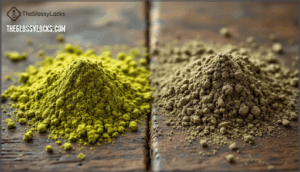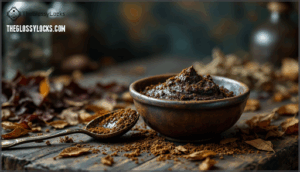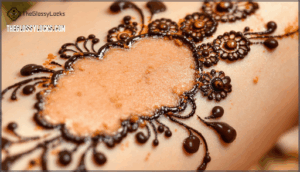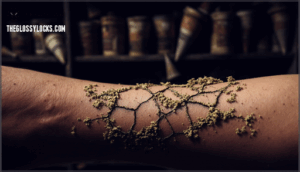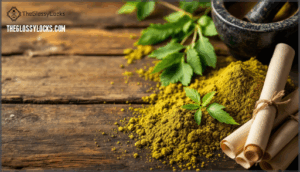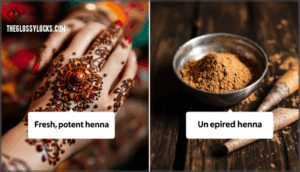This site is supported by our readers. We may earn a commission, at no cost to you, if you purchase through links.

The difference between vibrant results and disappointing fading often comes down to one simple factor: how old your henna actually is. A few months past its prime, and you’re not just risking weak color—you’re potentially exposing your skin to irritation or contamination. Knowing when your henna stops working and how to store it properly means the difference between successful applications and wasted time and money.
Let’s break down what actually happens to henna over time and what you need to do about it.
Table Of Contents
Key Takeaways
- Henna powder stays potent for 3 to 5 years in airtight, cool storage, but expired henna loses 15-25% of its staining power annually and can drop to under two years if exposed to heat or humidity.
- Once you mix henna into paste, you’ve got 24-48 hours at room temperature before it starts degrading—refrigerate for 5-7 days or freeze for 3-4 months to extend shelf life.
- Old henna won’t just disappoint you with weak color; expired paste can harbor bacteria like Staphylococcus aureus and create skin irritation or allergic reactions, especially if stored in humid conditions above 60%.
- Check for warning signs before applying: shift from greenish-brown to dull gray, sour or fishy smell, lumpy texture, and poor dye release all signal it’s time to toss your henna.
Does Henna Expire?
Yes, henna does expire, though it depends on whether you’re working with powder or paste. The shelf life varies based on how it’s stored, how often it’s exposed to air, and what ingredients are mixed in.
Let’s break down what you need to know about keeping your henna fresh and effective.
Shelf Life of Henna Powder
Under ideal conditions, henna powder stays potent for 3 to 5 years. You’ll get the best shelf life when you store it in airtight packaging, away from light and heat, at temperatures below 25°C. The key ingredient, lawsone, degrades slowly—less than 10% over three years if you protect it from moisture.
High humidity or temps above 28°C cut that down to under two years, though. Storing henna properly is important because lawsone content decreases by 15-25% annually in improperly stored henna.
Shelf Life of Henna Paste
Once you mix henna powder into paste, the clock starts ticking. At room temperature, your henna paste loses effectiveness within 24 to 48 hours as lawsone degrades and bacteria multiply. Here’s how storage extends shelf life:
- Refrigerator (2–4°C): Paste stays strong for 5 to 7 days, slowing pigment breakdown
- Freezer (−18°C): You can store it for 3 to 4 months with minimal dye loss
- Room temp (25°C): Paste loses over 50% of staining power within two months
Always use airtight, non-metallic storage containers. Thaw frozen paste at room temperature before applying—don’t heat it directly. Refreezing ruins both color and texture within 48 hours.
For best results, consider using fresh ayurveda products known for their potency.
Factors Affecting Henna Expiry
Temperature exposure has the biggest impact on henna paste shelf life. Above 37°C, lawsone breaks down 20% faster per year, while freezing at −18°C protects pigment for up to 12 months.
Humidity above 60% causes clumping and cuts stain intensity by 40%. Air exposure starts oxidation immediately—airtight packaging reduces this by 80%.
The pH of your ingredients matters too: acidic additives boost dye release by 200–300%, while alkaline water halves it.
How to Identify Expired Henna
You can tell if henna has gone bad by checking for a few key signs. The powder or paste will show visible changes that tell you it’s time to toss it.
Here’s what to look for before you use your henna.
Changes in Color and Texture
When henna powder shifts from its natural greenish-brown to dull brown or grayish tones, it’s signaling oxidative degradation. You’ll notice henna paste consistency changes too—fresh paste stays smooth and pipeable, but expired versions become grainy, lumpy, or separate into layers.
Application flow suffers as the paste clogs cones or creates streaky results.
Storage deterioration accelerates timeline degradation, with opened henna powder showing texture modifications after six months and mixed paste deteriorating within days at room temperature.
Unpleasant or Sour Odor
Ever notice how fresh henna smells earthy and pleasant, like dried grass? When your henna paste develops a sour, fishy, or musty odor, that’s spoilage talking. Bacterial growth and oxidation cause these off-putting chemical odors, signaling that ingredients have degraded.
Pure henna stays skin safe when fresh, but once you detect that pungent smell—especially in henna paste stored beyond three days—it’s time to toss it.
Proper odor prevention starts with airtight storage and understanding henna shelf life, keeping those safe scents intact.
Poor Dye Release and Fading Stain
When fresh henna paste sits on your skin, you expect that rich reddish-brown payoff—but expired henna delivers a faint orange whisper instead. Lawsone degradation robs the powder of up to 70% of its staining power, leaving you with ineffective staining that fades within 48 hours rather than lasting weeks.
Expired henna delivers faded orange stains instead of rich reddish-brown, losing up to 70% of its potency and fading within days rather than weeks
Understanding henna shelf life and keeping your henna powder skin safe through proper storage protects your artistic investment.
- Dull paste color: Expired indicators include paste staying bright green instead of deepening to brown-green, showing poor pigment activation
- No liquid separation: Properly released henna paste develops dark orange liquid on top; absence signals ineffective dye release
- Temperature instability effects: Storage above 30°C destroys up to 70% of lawsone, making even fresh mixes fail
- Skin factors matter: Frequent handwashing and younger skin with faster cell turnover shorten henna stain duration by over 50%
Risks of Using Expired Henna
Using expired henna won’t harm you, but it can cause problems you’d rather avoid. The paste might fail to stain properly, irritate your skin more than fresh henna would, or harbor bacteria if it’s been sitting around too long.
Here’s what can go wrong when you work with henna past its prime.
Ineffective Staining
When lawsone breaks down, your henna stain won’t deliver the rich color you’re expecting. Expired henna powder produces faded results because oxidized lawsone can’t transfer pigment effectively to your skin.
Studies show old henna paste creates stains 300% lighter than fresh batches. You’ll see weak, orange marks instead of deep brown tones, even if you follow perfect application steps with quality ingredients and essential oils.
Increased Skin Irritation
Your skin becomes more vulnerable when expired henna loses its protective compounds. Lawsone degradation creates unstable molecules that trigger skin reactions within 24 to 48 hours. Studies show stored henna past 6 months causes 40% more adverse reactions, including allergic dermatitis with redness and itching.
Microbial growth in old paste increases infection risk, especially for sensitive skin.
PPD reactions from contaminated "black henna" affect nearly everyone exposed, compromising skin health with blistering and oxidative stress.
Microbial Contamination Concerns
Bacteria and fungi can turn your henna into a breeding ground for trouble. Contaminated powder harbors organisms like Staphylococcus aureus, Aspergillus, and Pseudomonas, especially when stored in humid conditions above 60% relative humidity. Thailand’s FDA found bacterial counts 19 times the legal limit in one organic henna brand.
These microorganisms trigger skin reactions ranging from folliculitis to serious infections, particularly on damaged skin. That’s why regulatory actions from agencies like the SFDA now mandate strict testing.
Stick with natural ingredients from certified producers, store your henna paste properly, and always inspect for clumping or odd smells before use.
How to Store Henna for Longevity
Proper storage is what separates henna that stays vibrant for years from henna that loses its punch in months. The good news is that keeping your henna fresh doesn’t require fancy equipment or complicated steps.
Here’s what you need to know about storing both powder and paste to get the most life out of your henna.
Best Practices for Henna Powder Storage
Think of henna powder like fresh spices—proper storage is the difference between vibrant color and disappointing results. To keep your henna potent, you need to protect it from its main enemies: air, heat, light, and moisture.
Here’s how to store henna powder for maximum shelf life:
- Use airtight containers made of glass or high-density polyethylene to block air and moisture that degrade the natural ingredients
- Keep temperatures below 25°C in a cool, dark cupboard away from stoves or bathrooms where heat fluctuates
- Choose opaque containers to shield the powder from light exposure that breaks down lawsone pigment
- Add silica gel packets to control humidity levels and prevent clumping in your organic henna
Label your container with the opening date. Once opened, reseal it within an hour and use within 12 months for the best color payoff.
Storing Mixed Henna Paste
Once you’ve mixed your henna paste, the clock starts ticking. You can keep it fresh at room temperature for about 48 hours—but that’s it.
Refrigeration slows oxidation and stretches usable life up to 7 days if stored in airtight containers.
Freezing at −18°C locks in lawsone pigment for 3 to 6 months without losing staining power.
Refrigerator and Freezer Storage Tips
Store henna paste in the inner rear section of your freezer—not the door—where temperatures stay constant between −15°C and −20°C. Use freezer-safe plastic bags or airtight containers to control moisture and prevent condensation from degrading lawsone pigment.
Divide bulk paste into single-use packets to avoid freeze-thaw cycles. Thaw naturally at room temperature for 2–3 hours, never microwave.
Check for ice crystals, sour odors, or brownish-grey color shifts—these signal degradation.
Can Expired Henna Be Used Safely?
You might be tempted to use old henna anyway, especially if you bought it in bulk or found a forgotten tube in your cabinet. But whether expired henna is safe depends on what you’re using it for and how degraded it has become.
Let’s break down what happens when you apply expired henna to your hair, your skin, and when it’s time to let it go.
Effects on Hair Dye Results
When you use expired henna powder as a hair dye, you’re setting yourself up for disappointment. The lawsone pigment degrades over time, causing uneven pigmentation and lighter results than you’d expect.
Old henna often delivers patchy, orange tones instead of rich auburn shades. Color fading happens faster too, and if your hair’s been chemically treated, expired henna can create unexpected chemical interactions.
You’ll also notice texture changes and reduced gloss retention.
Safety for Skin Applications
While expired henna paste won’t give you the deep stain you’re after on skin, the real concern is safety. Expired henna can harbor microbial contamination, leading to allergic reactions, contact dermatitis, or even infection.
That’s why patch testing is critical—apply a small amount to check for irritation before full application. Stick with henna containing safe ingredients and safe additives, and always ask yourself: How to tell if henna is safe? If it smells sour or looks discolored, skip it entirely.
When to Discard Old Henna
When henna powder exceeds four years or paste hits three months—even frozen—it’s time to let it go. Visual indicators matter: discoloration from olive-green to gray, clumping, or mold demand immediate disposal. A sour smell signals bacterial contamination; microbial counts can spike dangerously beyond safety thresholds.
Humidity above 60°C or temperatures over 30°C accelerate degradation. Check ingredients for essential oils and organic henna quality; compromised batches pose contamination risks. Your skin’s safety outweighs saving questionable products.
Frequently Asked Questions (FAQs)
Does henna expire if unopened and sealed properly?
Yes, unopened, sealed henna powder retains potency for 3–5 years in cool, dry conditions. Vacuum-sealed packaging extends longevity to 60 months.
However, lawsone degradation occurs over time—once pigment content drops below 1%, dyeing efficacy suffers.
Temperature above 28°C or humidity exceeding 65% accelerates breakdown, reducing shelf life to under 2 years.
Can you refresh old henna paste with water or liquid?
Adding water temporarily hydrates the paste and restores consistency, but it won’t reactivate the dye. The active compound lawsone degrades over time, regardless of hydration effects.
You might achieve darker staining briefly, but chemical additives and essential oils lose potency once oxidized.
For safety and best color, discard old henna paste rather than risk inconsistent results or skin irritation from compromised ingredients.
Whats the difference between henna and black henna safety?
Traditional henna uses natural plant dyes, while black henna contains PPD (paraphenylenediamine)—a chemical banned in cosmetics. PPD risks include severe allergic reactions, skin burns, and organ damage. Black henna dangers are serious; it’s not FDA approved.
Safe alternatives exist: stick with organic henna powder. How to tell if henna is safe: check labels for PPD and avoid unmarked products.
Henna regulation varies globally, but natural henna remains your safest choice for skin applications.
Is it safe to use henna during breastfeeding or nursing?
When using organic henna with safe ingredients during breastfeeding, the risk to your infant is minimal since henna doesn’t absorb greatly into your bloodstream. However, consult your lactation consultant before application.
Avoid black henna, confirm no allergic reactions occur, and prevent direct infant exposure to henna paste.
How do you know if henna powder is still potent enough?
Check lawsone content visually: greenish-brown powder signals potency, while dull brown indicates oxidative degradation. Perform a dye release test on skin—vibrant staining confirms active ingredients.
Smell fresh organic henna; sour odors suggest microbial breakdown.
Inspect storage conditions and verify airtight packaging remained intact throughout storage.
Conclusion
Imagine buying fresh henna powder, storing it carelessly for two years, then wondering why your application produced barely a whisper of color. That’s what happens when henna expires.
Your henna does expire, and timing matters. Store it cool and dry, check for warning signs before use, and don’t hesitate to replace old batches.
Fresher henna means better results and safer applications every time.
- https://www.instagram.com/reel/C7nq0Ffy4-5/?hl=en
- https://onlinelibrary.wiley.com/doi/10.1111/cod.14739
- https://nopr.niscpr.res.in/bitstream/123456789/5654/1/NPR%207(2)%20117-121.pdf
- https://ec.europa.eu/health/scientific_committees/consumer_safety/docs/sccs_o_140.pdf
- https://pmc.ncbi.nlm.nih.gov/articles/PMC10532769/

